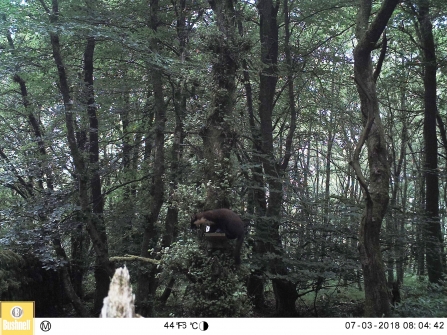
Camera footage. Image by: John Hartshone.

Camera footage. Image by: John Hartshone.
This is great news for the partnership of organisations working together for pine marten conservation in northern England, including Forestry Commission England, Northumberland Wildlife Trust, Aberdeen University and Vincent Wildlife Trust.
The cameras are in a remote area of Kielder Water & Forest Park as part of a red squirrel monitoring project and while many other species are frequently captured this is the first time pine marten have been spotted.
The images were first seen by John Hartshorne, who manages the fieldwork and ecology education firm Albion Outdoors and has been helping with the squirrel surveys known as Red Squirrels United (RSU) for several years now. John says: ”It is very common to see wildlife other than squirrels on the cameras I use. Badgers, foxes, deer and birds of all sorts are regular visitors.
This July I have caught some excellent pictures of red squirrels but also an unexpected visitor - a pine marten, sitting on top of one of the squirrel feeders. This was most unexpected but I now have both still pictures and a short piece of video firmly placing pine marten in Kielder Water & Forest Park.
Historically, pine martens were commonplace but habitat clearance and persecution has led to them being eliminated from nearly all of England."
Pine martens are elusive members of the weasel family and their biggest UK stronghold is in Scotland. Tom Dearnley, Forestry Commission Ecologist said: “As the forest nears 100 years in age, it is increasingly being colonised by rare and protected species. Pine marten returning to England, over the Scottish border, have been anticipated for some time and we are delighted to see photographic evidence of their return, a great endorsement of how we manage public forests.”
Ongoing studies in collaboration with the University of Aberdeen will provide evidence on how pine marten influence other species in Kielder Water & Forest Park, which have themselves previously colonised the maturing woodland.
Recent research carried out by Aberdeen University found that in Scotland, areas where pine martens were increasing, red squirrels also increased, but grey squirrel numbers plummeted drastically. This could have huge implications for organisations involved with trying to conserve reds in the UK and across Europe.
Simon O’Hare, Project Manager for Red Squirrels Northern England at Northumberland Wildlife Trust also commented: “It is well documented that grey squirrels out-compete red squirrels for food and also pass on a deadly virus, squirrelpox, to reds: this is one of the main reasons that the species in under threat. The natural return of pine martens in areas of northern England is an exciting prospect, as it could have a knock on effect by suppressing grey numbers, allowing native red squirrels to prosper once again in our woodlands.”
Being an important red squirrel reserve, partners at Kielder Water & Forest Park are very excited to welcome the pine marten into their woodlands. Kevin O’Hara, Pine Marten Project Officer Northern England with The Vincent Wildlife Trust said: “It is great news that we are starting to see further evidence of pine martens re-establishing themselves in northern England. The Trust has been heading a species recovery programme for pine marten in Britain for many years and is also excited to be part of such a varied group of organisations that are working towards the successful recolonisation of northern England.”